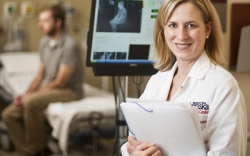Mar 23 2010
The University of Nebraska Medical Center (UNMC) researchers have discovered an Infrared Thermal Detection System (ITDS) that detects fever in patients by conducting measurements of skin temperature in a non-contact manner in a fraction of a second.
 Dr. Hewlett, Assistant Professor of Infectious Diseases at UNMC
Dr. Hewlett, Assistant Professor of Infectious Diseases at UNMC
The ITDS was discovered to be an effective and speedy fever screening system in healthcare units during the pandemic outbreak of H1N1 influenza. An initial symptom of infectious diseases such as SARS, seasonal influenza, avian influenza, and H1N1 is fever.
The OptoTherm ThermoScreen was evaluated at the Nebraska Medical Center’s Emergency Department by Dr. Angela Hewlett, UNMC’s Assistant Professor of Infectious Diseases, and her research associates during 18 November 2009 to 9 January 2010 when the H1N1 pandemic was at its peak. A thermal imaging camera is used by the ITDS for the measurement of skin temperature by the detection and quantification of IR energy that is emitted by the face. The researchers compared these measurements against standards-based temperature measurements made on 566 patients aged between 15 days and 89 years.
Several nations use IR thermal detection systems for screening patients for the presence of fever in travelers. Dr. Hewlett and her colleagues planned to use the system as an option for infection control during clinical examination settings. According to Dr. Hewlett, the ITDS technology will enable clinicians to scan persons for fever rapidly and identify incoming visitors and patients having fever for minimizing the hazards of spreading harmful diseases, such as influenza, to others in the hospital.
The clinical researchers had measured temperatures of participating patients using the ITDS at the Emergency Department, followed by routine rectal or oral measurements of temperatures in the Emergency Department’s triage area. Patients identified with fever were subjected to routine procedures such as isolation and masks.
The ITDS has proved its utility as an effective screening tool to identify patients having fever with temperatures above 100.0°F across all genders and ages. The ITDS was found to have a high negative forecasting value and precisely excluded patients not having fever. The ITDS also created large percentage of false positive results and measured temperatures that were found to be higher compared to normal temperature measurements. The study revealed that if the ITDS does not detect fever, there was a probability of 97% that fever is absent, rendering the ITDS a handy tool for fast screening of fever.
However, Dr. Hewlett revealed that the study had utilized oral temperature measurements as the base for measuring ITDS’s effectiveness. Oral temperature measurements are not correct always, but are mostly used to measure temperature during clinical settings. The ITDS needs additional evaluation relating to its utility and performance.
According to Cathryn Murphy, President of APIC, this technology will be useful for healthcare professionals when infectious diseases rapidly affect global populations in this era of globalisation. These professionals will be able to rapidly screen many patients and precisely for implementing requisite measures for preventing the transmission of diseases further.